the place where Paleontology and Paleoanthropology meets Philately
Ivory Coast
Dinosaurs and other prehistoric animals on stamps of Ivory Coast
| << previous country | back to index | next country >> |
Contents:
- Country overview
- Philately of Ivory Coast
- Official stamps of the Ivory Coast related to Paleontology
- Other stamps of Ivory Coast to consider
- References
- Acknowledgements
Ivory Coast became a protectorate of France in 1843–44 and was later formed into a French colony in 1893 amid the European scramble for Africa. Ivory Coast achieved independence in 1960. It maintained close political and economic association with its West African neighbors while at the same time maintaining close ties to the West, especially France.
Ivorian economy is largely market-based and still relies heavily on agriculture, with small holder cash-crop production being dominant. The official language is French. [R1]
The colony received its own stamps in November 1892, just a few months prior to formal establishment. As typical for French colonies of the time, these were of the Navigation and Commerce design, with 13 values ranging from 1 centime to 1 franc.
Four of the values were reissued with color changes in 1900, and several were surcharged in 1904 and again in 1912. The colony participated in the West Africa commemorative stamp of 1906, and in 1913 an issue of stamps depicting a river scene started a long series that continued in use until the mid-1930s.
On 1 October 1959, the first issue of the new republic went on sale. The three values depicting an elephant, and were inscribed "République de Côte d'Ivoire". A stamp was released in December depicting the the country's first president, Félix Houphouët-Boigny. The first definitive series of the republic, in 1960, depicted masks from various tribes. [R2]
In 2014 Stamperija (stamps production agency in Lithuania) issued
almost 60 Sheets and Blocks on behalf of the country, most of them show local fauna,
some of them depicted dinosaurs that roamed Africa in the past.
According to the agency they provided stamps issue services for Ivory Coast during 2014 only.
Official stamps of Ivory Coast related to Paleontology: dinosaurs and other prehistoric animals
| 10.03.2014 "African Dinosaurs" [1] [2] | ||
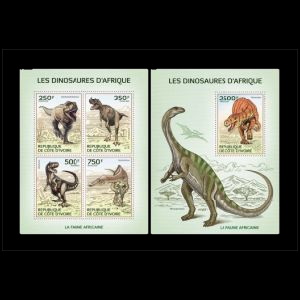 |
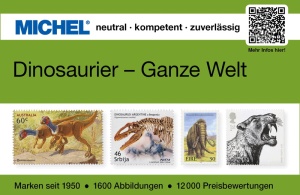 |
|
Notes:
[1] Fossils of all dinosaurs depicted on the stamps were indeed discovered in Africa. [R3]
- Carcharodontosaurus
is a genus of carnivorous dinosaurs that existed during the Cenomanian stage of the mid-Cretaceous Period.
In 1924, two teeth were found in Africa (Algeria), showing what were at the time unique characteristics.
A skull of Carcharodontosaurus was found in the Kem Kem Formation of Morocco during an expedition led by paleontologist Paul Sereno in 1995, near the Algerian border and the locality where the teeth was found for more than 70 years ago. - Ceratosaurus, was a carnivorous, medium-sized theropod dinosaur in the Late Jurassic period. Its fossils found in North and South America, Europe and Africa (Tanzania).
- Allosaurus,
is a genus of carnivorous theropod dinosaur that lived 155 to 145
million years ago during the late Jurassic period.
Many Allosaurus fossils have come from North America's Morrison Formation, with
material also known from Portugal and Africa
(Tanzania).
Allosaurus appears on many stamps issued around the world.
- Suchomimus,
is a genus of spinosaurid theropod dinosaur that lived
between 125 and 112 million years ago in Africa
(Niger), during the Early Cretaceous Period.
The animal was named and described based on a partial skeleton from the Erlhaz Formation. Its long and shallow skull, similar to that of a crocodile. Some palaeontologists consider the animal to be an African species of the European spinosaurid Baryonyx. Like other spinosaurids, it likely had a diet of fish and small prey animals. - Afrovenator, is a genus of theropod dinosaur from the middle Jurassic Period of northern Africa. The remains of Afrovenator were discovered in 1993 in the Tiourarén Formation of the department of Agadez in Niger.
- Massospondylus shown on the margin of the Souvenir Sheet,
is a genus of sauropodomorph dinosaur from the Early Jurassic Period.
It was described by Sir Richard Owen in 1854 from remains discovered in South Africa,
and is thus one of the first dinosaurs to have been named.
Later on, some more fossils of Massospondylus were found in Africa: Lesotho, and Zimbabwe, as well as in Asia, North and South America.
The image on the stamp is based on restoration of Massospondylus carinatus made by Nobu Tamura.
[2] In 2017, three years after their contract with the Ivory Coast expired, Stamperija produced 4 additional mini-sheets. These souvenir sheets are shaped like continent of Africa and have stamps using artwork from the 2014 Souvenir-sheet.
These additional Souvenir-Sheets are probably unofficial (Cindrella) issue and not valid for postage.

Other stamps of Ivory Cost to consider
| 27.11.1976 "200 years of independence of US" [A1] | 13.10.1979 "Fishes" [A2] | |
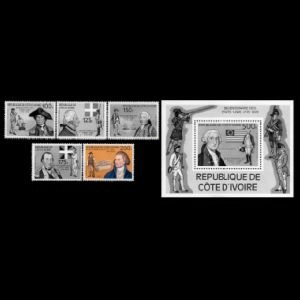 |
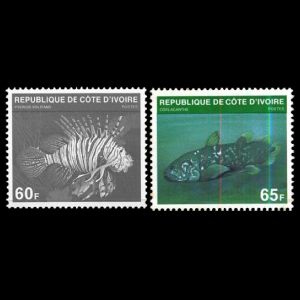 |
|
Notes:
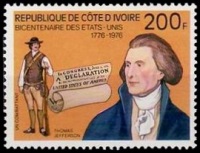
|
| Thomas Jefferson on stamp of Ivory Coast 1976 MiNr.: 501, Scott: |
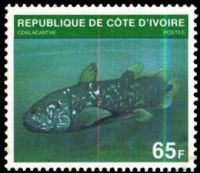
|
| Coelacanth fish on stamp of Ivory Coast 1979. MiNr.: B613, Scott: 521B |
Thomas Jefferson is rightfully renowned as the principal author of the Declaration of Independence, the Third President of the United States, and a champion of Liberty. But he was also a central player in the beginnings of American paleontology. In addition, his participation occurred at a time when people were struggling with the ideas of fossils as evidence of past life, of extinction, and of an Earth far older than the Biblical account.
Some of the fruits of Jefferson's paleontology became part of the collections at the American Philosophical Society in Philadelphia. Beginning in 1849 these holdings were transferred over to the Academy of Natural Sciences of Philadelphia, where they are currently housed. [R4]
[A2] The stamp with face value 65f shows a Coelacanth fish.
On 20 February 1939, the stunning announcement was made that a Coelacanth (Latimeria) had been caught off the Chalumna River mouth near East London (a city in South Africa). At that time, the Coelacanth was thought to be extinct for nearly 70 million years. The drama commenced on 22 December 1938, when Capt H Goosen, skipper of the trawler Nenrine, brought ashore a peculiar metallic-blue, heavily-scaled fish with fins resembling legs. Miss Marjorie Courtenay-Latimer, Curator of the East London Museum, was informed of the strange catch, but was unable to identify the fish, which measured 1,5 m in length and weighed 57 kg. [R5]
References:
- [R1] Ivory Coast: Wikipedia, WikiTravel, FlagCounter.
- [R2] Postal History and Philately of Ivory Coast:
Wikipedia,
Links to official website of the Post Authority, stamp catalog and a list of new stamps of Ivory Coast are here - [R3] African Diosaurs:
- [R4] Thomas Jefferson: contributors to Paleontology science in Philately, Thomas Jefferson on stamps of USA.
- [R5] Coelacanth: Wikipedia, ENCYCLOPEDIA Britannica,
Acknowledgement:
Many thanks to Dr. Peter Voice from Department of Geological and Environmental Sciences, Western Michigan University, for reviewing the draft page and his valuable comments.
| << previous country | back to index | next country >> |